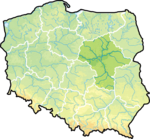Happy Dog Monument
2004 establishments in Poland2004 sculpturesBuildings and structures completed in 2004Monuments and memorials in WarsawOchota ... and 3 more
Outdoor sculptures in WarsawSculptures of dogs in PolandStatues in Poland

The Happy Dog Monument (Polish: Pomnik Szczęśliwego Psa) is a statue of a Golden Retriever dog in Warsaw, Poland, placed in the Mokotów Field park complex, within the district of Ochota. It was designed by Bogna Czechowska, and unveiled on 2 October 2004.
Excerpt from the Wikipedia article Happy Dog Monument (License: CC BY-SA 3.0, Authors, Images).Happy Dog Monument
Rokitnicka, Warsaw Ochota
Geographical coordinates (GPS) Address Phone number Website Nearby Places Show on map
Geographical coordinates (GPS)
| Latitude | Longitude |
|---|---|
| N 52.211111111111 ° | E 20.992777777778 ° |
Address
Lolek Grill & Bar
Rokitnicka 2
02-131 Warsaw, Ochota
Masovian Voivodeship, Poland
Open on Google Maps
Phone number
+48602101701;+48228256202;+48602685795









